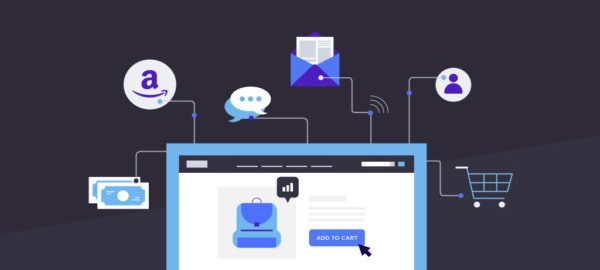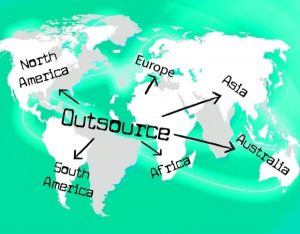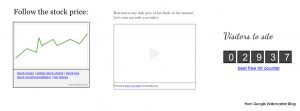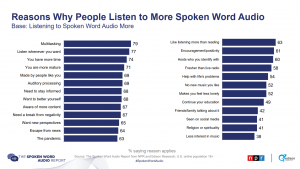
Many online sellers start out with Amazon as a single distribution channel. After all, Amazon is making it easier and easier for entrepreneurs to start a physical product business. To oversimplify it, all you need to do is find a product, list it for sale, send it to Amazon and they do the rest.
Plus, Amazon is where most buyers start and stop their shopping experience. Data shows 48% of online shoppers begin their search on Amazon versus anywhere else. This makes the Amazon audience unmatched elsewhere on the web. It is why sellers are able to build multiple six and seven figure businesses with an Amazon-only approach.
If you are only selling a product, the Amazon-only approach is perfectly fine. However, if you are building a brand, you need to consider your off-Amazon strategy.
Whether your goal is to build a multi-million dollar brand or just create passive income, expanding your brand beyond Amazon is critical.
Of all U.S. B2C ecommerce sales ($ 393B), 55% is sold through branded stores vs. 45% via marketplaces. The breakdown of that 45% ($ 177B) on marketplaces is:
- 36% Amazon
- 8% eBay
- 1% Etsy + other
Selling Amazon-only earns your brand 36% of the 45% of consumer shopping dollars –– but you’re still missing out on 55%.
Beyond an increase in sales through a webstore channel, however, launching a webstore helps to grow your sales even on Amazon. Here’s how.
Four Ways a Branded Webstore Can Increase Your Sales on Amazon
1. Expanding Beyond Amazon for Brand Validation
We know that shoppers are increasingly using mobile devices to make online purchases when they are in a physical store. We also know that consumers are using the web to validate purchases. So, if a shopper is looking at your product on Amazon and wants to find out more, where is the first place they are going to look?
That’s right –– your website.
Having your own website becomes an instant validation –– a proof point for trust and business validity –– for someone looking at or for your product.
A company’s website doesn’t need to be a full ecommerce retail operation. That might not be your goal on day one. Before anything else, your website needs to be a source of brand validation. It is where you share your brand story, expand on product features and offer your contact information. This additional context provides the shopper with increased assurance for the product they are buying.
The more expensive or complex your product is, the more critical your website becomes in closing the sale.
2. Expanding Beyond Amazon for Amazon Brand Registry
Another strong argument for developing your own website is applying your brand to Amazon Brand Registry.
Once your product is approved in the registry, you control the product detail page. This means other sellers cannot change your listing and that you become the single source of truth of your own product.
If you lack brand registry, you open yourself up to other sellers posting photos, updating your test or changing your description.
Applying for brand registry is easy, but before you can apply, you must confirm a couple things. To apply for brand registry, Amazon Requires:
- That your product and packaging have your logo.
- A website with contact information for registry validation.
Having Amazon brand registry is something that is recommended for every brand on the Amazon marketplace. Here are Amazon’s reasons for why brands, especially those selling unique products, should apply for brand registry:
- Increased authority over listing content for your products: Registering your brand with Amazon gives you increased control over your products’ titles, details, images, and other attributes. It also has the potential to reduce matching errors that may occur during listing.
- Amazon-issued product IDs that can be used in place of UPCs: Registering your brand allows you to list your products without standard product identifiers, such as UPCs and EANs. Enrollment assigns a Global Catalog Identifier (GCID) to your products, which you can use in place of the standard product ID. (Although we recommend that you continue to include your products’ standard IDs if they exist.)
3. Expanding Beyond Amazon for Customer Engagement
Finally, your website is a bridge for your brand. As your sales grow, so too will your brand recognition.
As consumers use your product, they will post on their Facebook wall. They will take a picture for Instagram. They may even make a video for Youtube or find some other way to share with their friends the experience they are having.
And as people share their experience with your brand, you want a website that can reinforce that brand message and build a bridge for people who may be looking to buy direct.
When consumers visit your site, you have a chance to capture their email and engage with them in a more personal way. This is how you begin to create lifetime customer loyalty and build a valuable email list. These are customers who can market to without having to pay for advertising or optimize for search (though your efforts in those two areas for increased return should be on-going).
An email list is the cheapest way to effectively communicate with your fans and build a loyal customer base that buys often.
4. Expanding Beyond Amazon for Wholesale Opportunities
One other thing to consider is expansion into other retail channels. As purchasing managers look at your product, they will go to Amazon and read your product reviews. Next, they will go to your website.
Your website is your online 24-hour, 365-days a year sales person. It is here these managers will find out how to contact you and build larger deals for additional product distribution through wholesaler relationships with the likes of Walmart, Kohls, etc.
Building a website isn’t the first thing Amazon sellers think about, but as your brand grows it is something that should be considered.
Now that you know the main reasons for building your own site, let’s look at some of the pros and cons of owning your site and having your own retail channel.
The Pros and Cons of Building an Ecommerce Website
In 2000, U.S. ecommerce sales equaled $ 27.6 billion. Current U.S. ecommerce sales are $ 394.86 billion. This represents 1,331% growth.
Ecommerce remains a high-growth market globally as well: 23% year-over-year growth. In the U.S., ecommerce growth year-over-year is 15-16%.
And yet, 46% of SMBs still do not have a website.
According to Custora Ecommerce Pulse, while online orders increased 8.9% in Q3 2017 year-over-year, average order value was only up 0.2%, indicating that most of the growth is driven by increasing numbers of transactions.
Of all U.S. B2C ecommerce sales ($ 393B), 55% is sold through branded stores vs. 45% via marketplaces.
The biggest pro of launching an ecommerce store if earning a share of that 55% of consumers shopping only through branded websites.
How to Build an Ecommerce Store
Here is a step-by-step on how to build and launch a profitable online store (seriously).
Here are 5 more pros, plus 4 cons and easy solutions to prepare for your webstore journey.
Pro 1: You build a 1:1 relationship with your customers
Amazon is highly protective of their customers. They have many policies which regulate what Amazon sellers can and can’t do with buyers.
When you own your own webstore, you control this relationships. Collecting your customer’s information allows you to build repeat customers and dedicated brand followers. Owning the customer relationship allows you to own the sale.
Con 1: You drive the traffic
Before you can build that relationship, however, you have to bring customers to your door.
The reason that Amazon is so dang attractive is because of all the traffic they own. Gone are the days of starting your search on Google. When online users want to buy something, almost half the web goes straight to Amazon.
When you own your own webstore, you are responsible for driving traffic. Traffic can be driven in a few different ways including pay per click, SEO, list building or social media.
How to Drive Traffic to Your Store
There are tons of ways to drive traffic to your site. The below are the most cost effective tactics BigCommerce merchants have used.
- SEO: In the current earn of search engine rankings, turning product pages into content-rich landing pages optimize those pages not only for conversion –– but for traffic, too. Why is this? Because web pages with more than 300 words and high engagement rates are pushed to the top of search results quicker. Using your product pages to accurately describe your product, show how it was made, produce a video on how it is used and have an ever-growing section of customer reviews signals to Google that your page is relevant, updated and useful.
- Email Marketing: Once you get customers in –– or once you start building an email list –– it is essentially free to market to them via email. Better yet, email marketing is still one of the most effective marketing tactics out there. This is because a customer has willingly given you their information and thus their permission to market to them. Email marketing can be automated –– and the ROI is easily viewable in low-cost software to prove the value of each email and allow you to optimize for results.
- PPC: Like on Amazon, webstores use PPC to drive traffic and clicks. The two channels used most often (and that have the highest ROAS) are Google Shopping and Facebook Ads. Ecommerce platforms integrate directly with these solutions for real-time product updates. And, Facebook has complex targeting opportunities that allow you to test your message, grow your audience and ultimately close more sales.
Pro 2: You nurture and earn repeat customers
Once you own the customer relationship, you can encourage customers to become repeat buyers by suggesting other products that you sell. In retail, this is called lifetime value. It’s a calculation in how much revenue you will earn from a customer.
When you sell on Amazon, it’s difficult to build a relationship for repeat purchase and it’s against the terms of service to suggest other products for them to purchase.
Con 2: You set up a nurture stream
To be honest, you don’t have to set up a nurture stream. It is in your best interest to set up a nurture stream, though. This is because a nurture stream automates your email correspondences with customers, thus driving up engagement and sales without much work on your part.
You do have to set it up, though.
How to Setup a Nurture Stream
There are multiple types of nurture streams –– and each one can be set up in an ecommerce or email software backend quickly and easily. Here’s a quick overview of the most common ecommerce nurture streams:
- Welcome series: A welcome series is a series of emails sent out to new customers or even just newsletter subscribers welcoming them to your brand. This series typically includes 3 emails sent over the course of a week. The first email is a welcome email explaining who the brand is and what the customer can expect. The second email shows off a couple best selling products with a first-time-buyer discount code (5-20%). The third email typically tells the customer about a weekly or monthly newsletter and encourages them to sign up to stay informed of new products and sales.
- Abandoned cart series: An abandoned cart series is a series of emails sent out to customers who have added items to their cart but not yet purchased. It is usually a series of 3 emails that are sent over the course of a few days, beginning a few hours after the cart is abandoned. The first email is usually a reminder of the product. The second often uses a psychological trigger to close the sales (only a few left in stock, for instance). And the third often contains a discount code.
- Upsell and cross-sell series: An upsell or cross-sell series is a series of emails triggered by a purchase. You can use your receipts as a kick-off to this series. After all, receipt emails are the most opened emails on the web. In these emails, you’d include products often bought with those items. These sometimes include discount codes. The goal is to get the customer to purchase again.
There are plenty of tools out there to help brands build and automate nurture streams. Here are a few favorites.
- Hubspot: Hubspot is a full fledged marketing automation platform that allows you to set up nurture streams based on customer personas.
- MailChimp: Mailchimp is one of the most popular email marketing software tools on the market. They make it easy to create cool templates, pull in buy buttons (which reduce friction on the conversion journey) and automate messages.
- Klaviyo: Klaviyo is an up-and-comer in the email marketing software tool world and is recommended by multiple influencers in the space. They offer email collection services on-site to help you build your list, and then automate message on the backend.
- Out-of-the-Box: Ecommerce platforms like BigCommerce offer email marketing tools out-of-the-box. For instance, BigCommerce’s abandoned cart email tool is free, easy to set up and often earns back 15%-18% of a brand’s abandoned carts.
Pro 3: You merchandise your products however you want
Your product, your brand, your message. When you own your own store, you follow the rules that you set. This allows you to display your products in the best way you see fit.
When you are on Amazon, you are restricted in how you talk about a product or the photos you can use. If you want to add videos, you have to be part of Vendor Central and pay an extra fee.
Having freedom to merchandise your product allows business owners to let creativity and merchandising drive sales.
Con 3: You need to be strategic about how you merchandise
Merchandising is more of a science than an art. Sure, website look like they are merchandised beautifully –– which might give off the connotation that they were artfully designed that way. But online, user experience is what matters most.
And what users want is both beautiful and seamless experiences. This means that your merchandising xefforts cannot be so distracting as to stand in the way of your checkout.
Instead, brands use collections on homepages and search optimized product pages to give as much information as possible, in as visually an appealing way as possible, all while leaving an add to cart and checkout button above the fold.
You can test the effectiveness of your merchandising efforts with A/B testing and site monitoring through tools like Optimizely and HotJar.
How to Strategically Merchandize
Here is a detailed how-to on visual merchandising –– and below are 11 of our favorite brands doing it incredibly well:
- Rollie Nation
- Hyphen Sleep
- Love to Dream
- Little Tree
- Hook & Albert
- Knobs Co
- Pro Compression
- Rad Soap Co
- Modavanti
- Harveys
- Fresh Fronks
Pro 4: You can tell your brand story
A brand is a story and how you present your brand should evoke an emotion. That is what great brands do.
While you can tell your story on Amazon, you are limited in how that story is told.
Con 4: You need to tell your brand story at every brand touchpoint
A brand touchpoint is every point at which a customer interacts with your brand. At each of these points, your brand needs to be using a similar look and feel to how it does on other channels. This is so that consumers visually connect the dots and better remember your brand for the next time they shop.
Here are a few touch points you will most likely have:
- Your Amazon sales channel
- Your webstore
- Your Facebook Business page
What needs to be similar across these channels? The following items:
- Logo and name
- Tone in copy description and ads
- Visuals like product and lifestyle photos
These items need to be similar, but not the exact same. In fact, they shouldn’t be the exact same.
Easy Design Services at Your Fingertips
Because you need similar items and because you already know what they items are, you can batch request though from services like 99Designs or Printful Design Services in order to knock out everything you need in one swoop. Printful even has a BigCommerce integration.
Pro 5: Diversification can save your business in the case of suspension
One of the biggest fears of every seller on Amazon is suspension.
Amazon suspension comes in many different forms and while only a small percentage of sellers will get suspended, it is a sobering reminder that you play in Amazon’s sandbox –– not your own.
As your seller account grows, so does the risk you take with being Amazon-only. You essentially have all of your eggs in one basket.
Moving to your own site and building your own brand provides the diversification necessary to build a sustainable business –– and offset the risk associated with potential suspension.
While your own site might lag in sales from your Amazon site at first, as you build your brand reputation your customers will begin to seek you out directly.
The narrative that Amazon is eating the market is simply not accurate
To repeat the numbers above, ecommerce has grown 1,331% in the last 16 years. It remains a high-growth market globally as well, with 23% growth year-over-year.
And in the U.S., of all B2C ecommerce sales ($ 393B), 55% is sold through branded stores vs. 45% via marketplaces.
The breakdown of that 45% ($ 177B) within marketplaces is:
- 36% Amazon
- 8% eBay
- 1% Etsy + other
Selling successfully on Amazon earns you a decent foothold in the ecommerce market. But you are also contributing to the 46% of SMBs which still do not have a website –– and aren’t cashing in on 55% of online sales in the U.S.
With 92% of people use multiple channels when shopping, the least you can do is launch a site, earn Amazon Brand Registry and create consumer validation and trust in your product. The best you can do is cash in on the $ 216 billion on the table.
Digital & Social Articles on Business 2 Community(91)
Report Post







